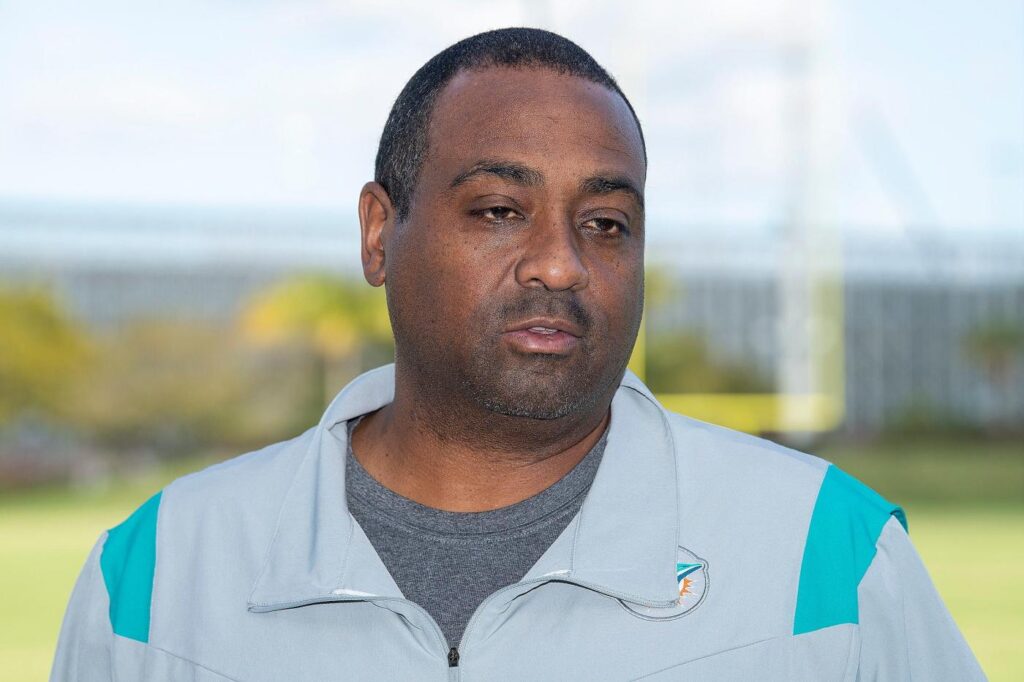
The Miami Dolphins’ new offensive scheme under coach Mike McDaniel could be a key factor in determining what they do with their two impending free agent tight ends.
Mike Gesicki and Durham Smythe have been joined at the hip since they entered the NFL together as members of Miami’s 2018 draft class, the last one Adam Gase had as coach of the franchise.
Smythe was the in-line, blocking tight end and Gesicki was the hot pass-catching commodity with his long, rangy 6-foot-6 build. Both made statistical strides through the three years of the Brian Flores era while also growing as best friends on the team. Gesicki has increased his receiving totals every year to the point of finishing with 73 receptions for 780 yards last season while Smythe also set career highs in 2021 with 34 catches for 357 yards.
Gesicki, though, has not made vast improvements in his run blocking over time. It often led the Dolphins’ offense to be predictable whether he was on or off the field. If Gesicki is in the game, Miami is more likely to pass. If he’s not, the likelihood the Dolphins run increases.
It inclined the Dolphins to use him on 72 percent of snaps in 2021, which was a career high, but it’s far off from how McDaniel had Pro Bowl tight end George Kittle, who is considered an all-around tight end, in on 92 percent of offensive snaps as San Francisco 49ers offensive coordinator last season. Gesicki also didn’t start in eight games last season, often because Miami might’ve been in a run-based set on the first play.
McDaniel, offensive coordinator Frank Smith and tight ends coach Jon Embree, who was with McDaniel and coach Kyle Shanahan with the 49ers, will have a decision to make on whether Gesicki’s blocking ability will suffice for the Dolphins’ new offense or, if not, whether they can overcome it.
“It’s important because our system is based off of outside zone,” said Embree, who also serves as assistant head coach, on having his tight ends be able to block. “[To] get on the edge or to get the corner, so to speak, it starts with your tight end. So, it’s an integral part of our offense.”
Embree is early in his evaluation of both Dolphins’ tight ends and, this past week, was going through the process of learning the college guys ahead of next week’s NFL scouting combine in Indianapolis. Shortly after the combine, the focus quickly shifts to free agency with March 8 the NFL deadline for teams to designate franchise and transition players, March 14 when free agent negotiations can begin and March 16 the official start of free agency.
With Gesicki and Smythe, Embree has had brief phone conversations with them.
“Both were doing well. Had great conversations with them,” Embree said. “They’re both excited about what’s on the horizon. We’ll see if it’s here or wherever. We understand it’s a business aspect, but we had good conversations and they seem like really nice guys.”
Complicating things with Gesicki, if the Dolphins want to place the franchise tag on him, he can possibly file a grievance appealing to the NFL that he deserves the receiver designation instead of tight end, which would carry a difference of around $7.5 million more. Since Gesicki isn’t much of a blocker, the Dolphins lined him up much more in the slot or on the boundary than in the traditional tight end position to play to his strengths.
Beyond decisions to make with Miami’s top two tight ends from last year, they also have Adam Shaheen, Cethan Carter and Hunter Long still under contract heading into 2022. Long was the Dolphins’ third-round draft pick in 2021 that largely remained behind the others on the depth chart as a rookie, making just one catch.
“I studied him a little bit, not in great detail just because we were in a situation where I knew we weren’t really going to get one,” said Embree of his evaluation of Long heading into the past draft while still with the 49ers. “When you know you’re not going to draft one, you study him, but you don’t go through with a fine-toothed comb.”
As far as evaluating Long’s limited rookie tape, Embree said: “It was his rookie year, so I’m not going to judge him harshly by what he did. Every rook’s like, ‘Oh, yeah, yeah, yeah,’ and then by Week 9, they hit the wall because that’s a college season. … It’s all a learning experience for a rookie. We’ll see what happens.”
In addition to the tight ends, it will be critical for wide receivers to block in McDaniel’s offense.
“It’s huge,” new wide receivers coach Wes Welker said. “That’s how we get explosives in the run game, and I think it’s something that you’ve seen a lot of teams kind of miss the boat on. It’s going to be a huge part of what we do. It’s a non-negotiable.”
He noted how receivers, once they see on tape how helpful their blocks are to the whole offense, including setting up the pass, they are largely receptive to it.
